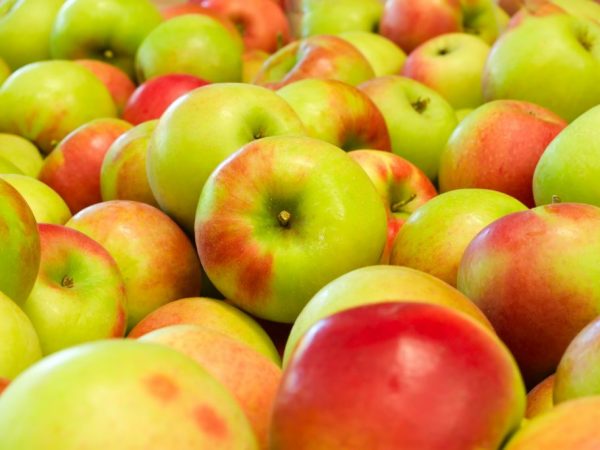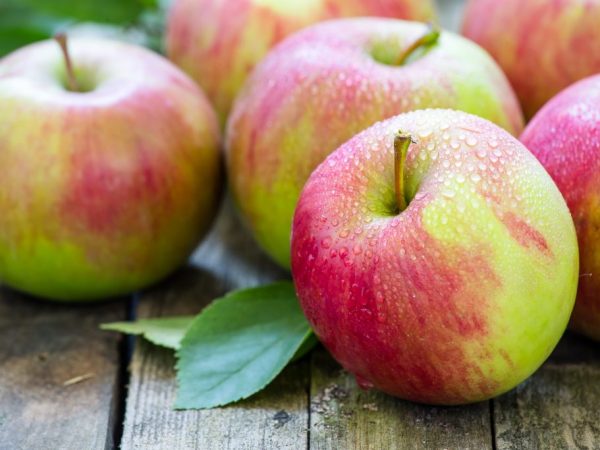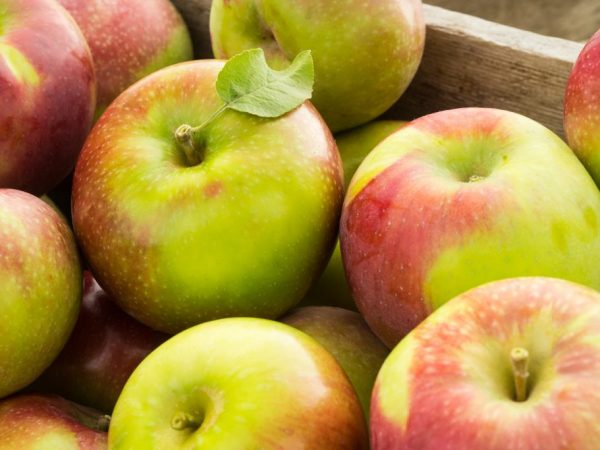Cultivation of the Sinap apple tree
The Sinap apple tree began to grow in the Crimea. Already in the 18th century, she gained great popularity among gardeners. There is more than one version of how this variety was bred. The most popular of them says that earlier in the Crimean territories in orchards, these fruit trees occupied 8% of the area. They appeared by chance, as a result of mutation of the seeds of the subspecies Sinap Sarah.
- Description
- Advantages and disadvantages
- Characteristics of the tree and fruit
- Taste
- Yield
- Pollinators
- Winter hardiness
- Disease resistance
- Place of cultivation
- Features of the tree depending on the stock
- Landing
- Timing
- Technology
- Care
- Watering
- Top dressing
- Pruning and shaping the crown
- Ripening and fruiting
- Harvesting and storage
- Varieties
- Khakass
- Minusinsky
- Mountain
- Belorussian
- Gardeners reviews

Cultivation of the Sinap apple tree
Description
To understand if this fruit variety is suitable for your garden, you need to know what the main characteristics it has.
Advantages and disadvantages
Due to the fact that the tree is unpretentious in courting, it has many advantages, which significantly exceed the disadvantages.
The variety is quite winter-hardy, apart from individual subspecies. Crimean and Northern - are not resistant to cold and require higher temperatures, therefore they bear more fruit in warm periods, for example, in autumn. Despite this, if these apple trees are properly protected, they will yield crops in Siberia.
The culture is distinguished by high productivity and sufficient early maturity. One adult tree can harvest 100 kg of apples. They are distinguished by an unforgettable sweet taste with a subtle hint of sourness. The pluses include scab resistance, although you still have to process the plant trunk and crown.
The peculiarity of the variety is that it is perfectly transported, and can be stored for 7-9 months. The fruits are used for drying, cooking compotes, baking and eaten fresh.
The disadvantages of the variety include:
- the trees are too large, therefore they are not suitable for growing in private areas in a few pieces;
- yield depends on weather conditions. The less cold the plant will endure, the more apples will be harvested later;
- with poor care and a large number of ovaries on the tree, the yield will drop and the quality of the fruit will significantly deteriorate. For apples to be really tasty and juicy, they must be fully ripe. Unripe fruits are bitter and difficult to store;
- the variety does not like drought and specifically reacts to dew;
- if the seedling does not have enough fertilizers, the fruits are then affected by the bitter pitting.
Characteristics of the tree and fruit
All trees grow to massive sizes. This fact must be taken into account when planting in order to allocate enough territory for the seedling so that it can take root, grow, receive the right amount of heat, lighting and bear fruit well.
The tree grows short, about 5 m, and the dwarf subspecies is no more than 3 m. The branches of the tree are rare, so the crown does not come out thick, which significantly affects the harvest.
The shoots of the plant are not thick, they descend, and the leaves on them are quite rare. They are green or dark green in color. Their shape is not completely round, the edge is slightly raised, but the leaf looks down.According to the type of fruiting, nothing specific can be said, because in this apple tree it is mixed and is different every time.
Fruits of the Sinapa variety are small in size. The weight of one apple is 120-150 g. The color of young fruits is yellow with a green sheen, with long-term conservation they acquire a golden hue.
An exceptional feature of this variety is that the side that has been in the sun takes on a reddish tint, like a blush. The rind is dense, rough, but easy to peel. If you store the fruits for a long time, then an oily coating will accumulate on it.
Apples contain a moderate amount of sugar - 9.7%, and when ripe, acidity and sweetness become almost equal. The pulp is white, tender and juicy.
Taste
Sinap apples are quite popular in terms of taste. Their flesh is fine-grained, loose and juicy. It has a wonderful taste, thanks to the harmony of sweet and sour notes, as well as a wonderful and rich aroma.
Yield

A very prolific apple variety
The variety is generous in harvest, but very finicky. From one adult apple tree, you can collect up to 170 kg of apples per year, and from more mature representatives - and 2-3 centners. Nevertheless, such a high yield is rare, because the apple tree bears fruit only once every 2-3 years.
For the apples to be tasty, after picking, you need to let them lie down for 3-4 weeks, because only then will they ripen. The fruits of the tree become fully ripe after the end of the warm summer period - in late August or early September.
Pollinators
The apple tree itself cannot bear fruit; for this, another 1-2 species of other apple trees are planted next to it. For Sinup, Sarah's Sinup, White Rosemary and Reneth of Orleans are suitable. With the help of such varieties of trees, this species will be able to give good yields.
Winter hardiness
The apple tree, which is of Crimean origin, cannot have high winter hardiness. In the variety, it is characterized as average. The tree can withstand short-term changes in cold temperatures, up to a maximum of -28 ° C without damage.
Some subspecies, such as Crimean and Northern, do not like winter. At temperatures lower than -28 ° C, trees begin to freeze, the root system suffers, therefore, due to improper care and planting, the plant may die.
Disease resistance
Both to cold weather and to various diseases, the variety has an average resistance. He copes with scab and powdery mildew, but not with other diseases and pests. To do this, the tree needs to be looked after, and when dry branches and rotten fruits appear, they need to be plucked so that the rest is not affected.
Place of cultivation
These varieties are grown in large, warm and sunny areas. Since they do not like the cold, they are more often planted in gardens on the territory of the Crimea. Some subspecies were bred specifically so that the plant could bear fruit in the Urals and Siberia, therefore the territory and region where the future fruit tree will grow is chosen depending on its resistance to cold weather.
Features of the tree depending on the stock
The stock is a cultivated seedling that affects how the apple tree will grow, what size of tree and fruit it will have, its yield, as well as its lifespan. There are several types of rootstocks.
On a vigorous rootstock, the tree reaches 7.5 meters in height and is unpretentious to care for. The first crops can be harvested only after at least 6 years after planting, and the plant will live up to about 60 years. Fruits from such trees grow small and weigh up to 100 g.
Semi-dwarf is an ideal option for gardeners, because the apple tree reaches a maximum size of 5 m. Its fruits are tastier, the plant is not picky to care for. Fruiting in a plant begins in the 3rd year after planting, and its fruits are slightly larger, and their weight is 110-130 g.
Dwarf Sinup begins to bear fruit as early as the second year after planting. This is a miniature tree, the growth of which will be no more than 3 m. Fruits of this variety are tasty, sweet, juicy, the weight of one apple is 140-150 g.Dwarf Sinapas bear fruit for 25-30 years.
Landing

The apple tree will yield a greater yield when planted in the fall.
In order for an apple tree to have a high yield, it must be properly planted and looked after.
Timing
It is better to plant this variety in the fall, and the most favorable period for this is mid-September-October. In the fall, holes are first dug, left for two weeks for the earth to settle, and then young trees are planted.
You can plant Sinap in the spring, only it is better to do it in early April, when the ground has already warmed up enough, but there is still no drought.
Technology
Initially, you need to remember that apple trees grow quite large, so there should be a distance of 5-7 m between each seedling. First of all, you need to prepare the pits. The depth of one should be at least 80 cm, and the diameter should be 1 m.
After two weeks, rubble is poured into the hole to prepare the drainage system. The soil must be fertilized. For this, the earth is mixed with manure and wood ash so that this bait makes up a third of the pit. They also add 40 g of potassium sulfate and 80 g of superphosphate, then add some more soil, and then you can proceed directly to planting trees.
If the seedling has dry roots, they need to be cut off and put into water for 4-5 hours. Then it is lowered into the hole, straightened all the roots and sprinkled them with earth by 6-7 cm, and then trampled. The tree should be immediately watered with 3-4 buckets of water.
The soil for planting is sandy or clayey. It is advisable to choose a place where the amount of groundwater is minimal, because apple trees do not like liquid stagnation.
Care
In order for a tree to be pleasing to the eye, grow and bear fruit, it needs proper care: timely watering, fertilization and pruning.
Watering
Water the tree every month once a week and depending on the weather. The amount of water is calculated as follows - 3-4 buckets per apple tree. Around the trunk, the soil is loosened with a shovel or boot so that the water reaches the root system.
Top dressing
You need to fertilize the plant according to the plan 4 times a year: when the winter period ends, when buds begin to form on the branches, after the apple tree blossoms and after harvesting in the fall.
The first feeding is done with humus or manure. 500-700 g per tree a year after planting. The second top dressing is done with urea - 500 g per seedling, after which the hole is dug up.
For the third time, the apple tree is fertilized with a mixture of synthetic fertilizers: superphosphate, urea and calcium chloride. You can add bird droppings to its composition, since it also contains many substances useful for the seedling.
The last feeding of the plant is carried out only with the help of superphosphate, which is taken in an amount of 30-50 g per 10 liters of water.
Pruning and shaping the crown
The branches of the Sinap apple tree grow intensively, which is why they need to be periodically cut off so that a beautiful and neat crown is formed in the tree. In the early years, branches are only cut by a third. After a year, they are cut off until only 3 tiers remain. Further pruning is carried out so that only fertile branches remain.
Ripening and fruiting
Apples grow on different shoots. The fruits ripen in August, and they are harvested in early September and allowed to stand for three to four weeks until they are fully ripe. The harvest does not start soon, it usually takes about 5 years for the tree to bear its first fruits. The yield is high, but it occurs only once every two to three years.
Harvesting and storage

Apples keep well
Based on the description, the harvest time is the beginning of autumn (optimal timing: September - October). This is the best time to pick apples, put them in crates and let them sit. If you transport unripe fruits, they will be well preserved, because ripe fruits do not tolerate transportation well.
It is beneficial for stores that apples can lie in the warehouse for another month and ripen, and they can be stored until spring if the conditions are met.
Varieties
Since the Sinap apple variety was bred for a long time, it is not surprising that thanks to it, many other varieties of fruit have already been obtained over the entire period of growth.
Khakass
The Khakassian autumn variety was obtained by crossing the Northern Sinap with the Rossosh striped one. The apple tree has a narrow-growing crown, the branches of which are directed upward. Its fruits differ little from the usual Sinap. They are slightly smaller, and only 50-60 kg can be harvested from one tree.
The weight of one apple is 170 g, they are oval, have a yellow-greenish color with a slight red tint. The Khakassian Sinap is frost-resistant, and its apples are soft, with a rich sweet taste and juicy pulp.
Minusinsky
Minusinsk variety of medium height, autumn. The crop can be harvested 5 years after planting. Apples weighing 50-60 g. All have a yellow-green tint with a pink-purple blush. The apples are very sweet, juicy and soft. This variety is cold and scab resistant.
Mountain
The mountain variety is fast-growing, but it ripens at the end of winter. Sinap Mountain is moderately resistant to low temperatures and scab. The fruits of the apple tree are large and round, the weight of one apple is from 170 to 300 g.
In shades, all apples are yellow-golden, with reddish areas in those places where the sun fell. They are soft, juicy and sweet, and are stored after harvest for up to six months.
Belorussian
The description indicates that the Belarusian variety is significantly different from others. It is fast-growing, vigorous and resistant in winter, almost not affected by scab, can grow in Siberia. This variety has a dense, wide crown and grows in the form of a pyramid.
The apples are large, round, the weight of one is 90-120 g. The skin is hard, golden, and the pulp is light-green in color, soft, juicy and sweet. The autumn apple tree bears fruit by the end of September.
Gardeners reviews
People who grow different types of Sinap in Moscow and other regions praise it. Many people like the fact that the tree is not picky and easy to care for. The price of seedlings is affordable. It is winter-hardy and does not lend itself to the influence of various diseases and insects.
Sometimes it is necessary to treat the trunk with insecticides, as well as slaked lime. Gardeners say there are many chemicals available to control more serious pests. They are effective and do not affect the fruit.

